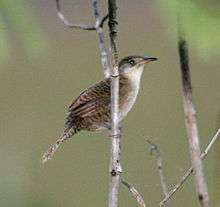Zapata wren
| Zapata wren | |
|---|---|
 | |
| Scientific classification | |
| Kingdom: | Animalia |
| Phylum: | Chordata |
| Class: | Aves |
| Order: | Passeriformes |
| Family: | Troglodytidae |
| Genus: | Ferminia Barbour, 1926 |
| Species: | F. cerverai |
| Binomial name | |
| Ferminia cerverai Barbour, 1926 | |
The Zapata wren (Ferminia cerverai) is a medium sized grayish-brown bird that lives in dense shrubs of the Zapata Swamp, Cuba. It is the only member of the monotypical genus Ferminia.
Measuring about 16 centimetres (6.3 in) in length, it is brown overall, though striped with black and with grayish underparts. Its tail is long.
The Zapata wren is confined and endemic to the Zapata Peninsula of southern Cuba. It was formally described by American herpetologist Thomas Barbour,[2] who gave it the specific name cevererai in honour of the wren’s discoverer, Fermín Zanón Cervera, a Spaniard who had stayed on after the Spanish–American War and become a professional naturalist.
Barbour had been accompanied by Cervera on his previous visits to Cuba, and on hearing of the strange birds to be found in the Zapata area, he sent the Spaniard on a series of trips into the region, eventually leading to the finding of the wren.[3]
The bird's song is similar to that of the house wren, in that it is high-pitched and loud, described as a "musical warble preceded by guttural note, given in series of three or four phrases."
The Zapata wren's habitat is typically freshwater marsh and lowland savanna with scattered bushes and low trees. It feeds on insects, spiders, small snails, lizards and berries. The wren typically makes its nest in sawgrass tussocks. It is thought to breed between January and July.
Typical threats are fires in the dry season, drainage of the wetlands, destruction due to agriculture, and predation by introduced mongooses and rats.
References
- ↑ BirdLife International (2012). "Ferminia cerverai". IUCN Red List of Threatened Species. Version 2013.2. International Union for Conservation of Nature. Retrieved 26 November 2013.
- ↑ Barbour, Thomas; Peters, James Lee (1927). "Two more remarkable new birds from Cuba". Proceedings of the New England Zoological Club 9: 95.
- ↑ Peters, James l (July 1948). "Thomas Barbour, 1884–1946" (PDF). The Auk 65 (3): 432–438. doi:10.2307/4080492.
External links
- BirdLife Species Factsheet
- Image of Cervera and his Zapata birds at Birding Cuba
- Zapata wren videos on the Internet Bird Collection
